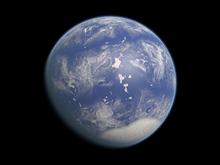Ocean planet
An ocean planet (also known as a water world ) is a hypothetical terrestrial planet shape whose surface is completely covered by water .
Overview
Planets that form in the outer areas of a protoplanetary disk of dust should consist of about 50% water and 50% silicates and should look like comets similar to so-called dirty ice balls. Simulations show that such planets migrate in the direction of their star under certain circumstances and melt there; thus ice planets would become water planets. The possibility of such planets was introduced into the astronomical-scientific discussion through scientific work by Marc Kuchner and Alain Léger.
properties
The oceans on such planets could be several hundred kilometers deep and therefore significantly deeper than those on earth . The high pressure at the bottom of such oceans could lead to the formation of a mantle of exotic forms of ice, although this ice need not necessarily be cold. If such a planet were sufficiently close to its sun, the water on it could become supercritical and no longer form a well-defined surface. The atmosphere on such as well as on cooler ocean planets is likely to be much denser than that on Earth and cause a particularly strong greenhouse climate. Ocean planets could harbor life .
Possible candidates
The exoplanet GJ 1214 b is the most likely known candidate for an ocean planet. Observations from the Hubble telescope have shown that the atmosphere of GJ 1214 b may be composed primarily of water vapor. For this and other reasons, it is believed that the planet itself is largely made up of water. The rediscovery of many more objects of this type by the Kepler Space Telescope is expected. On April 18, 2013, it discovered five planets in the Kepler-62 star system. Two of these, e and f , could be ocean planets. Since they are both in the habitable zone , they could also harbor life.
The planets Trappist-1 e and Trappist-1 f , discovered in 2017, could also be ocean planets.
Ocean planets in fiction
The motif of the ocean planet is also taken up in science fiction. So dive in the Star Wars universe Manaan , Mon Calamari , Kamino and Ahch-To on. It must be noted, however, that these are not pure ocean planets. Manaan, Mon Calamari and Ahch-To are described as having a few land masses. At the time of the plot, Kamino is an ocean planet, but in historical times it had land masses that sank into the sea as a result of global ice melt.
In the Star Trek series Star Trek: Spaceship Voyager , the eponymous ship passes the so-called Monean Water World, which is basically an ocean planet. However, it turns out that it was artificially created by using a gravity generator to suck the water of a planet into space and shape it into a ball.
In the film Waterworld , a global ice melt and other unspecified catastrophes have turned the earth into an ocean planet. Only Mount Everest still rises from the floods and is therefore called "Dryland". A similar scenario is described in an unnamed disaster series by Stephen Baxter . Erupting underground water caverns gradually flood the earth until almost no land protrudes from the floods.
In Interstellar, astronauts land on a water world orbit a black hole. Mountain-high waves roll over the knee-high water-covered planet at regular intervals.
In the three filmed novel Solaris by Stanislaw Lem a planet of that name is almost completely surrounded by a peculiar ocean, which apparently is an intelligent being.
In the video game Subnautica you are stranded on the water planet 4546B and have to survive there.
See also
Individual evidence
- ^ Scientists Model a Cornucopia of Earth-sized Planets. Goddard Space Flight Center , accessed August 15, 2018 .
- ↑ Marc Kuchner: Volatile-rich Earth-Mass Planets in the Habitable Zone , Astrophysical Journal , 2003, arxiv : astro-ph / 0303186 .
- ↑ Alain Léger: A New Family of Planets? "Ocean Planets" , 2003, arxiv : astro-ph / 0308324 .
- ↑ Stefan Deiters: GJ 1214B An exoplanet like no other . On: astronews.com of February 21, 2012, last accessed on September 9, 2013.
- ^ Zachory K. Berta, David Charbonneau, Jean-Michel Désert et al .: The Flat Transmission Spectrum of the Super-Earth GJ1214b from Wide Field Camera 3 on the Hubble Space Telescope. On: Astrophysics> Earth and Planetary Astrophysics. arxiv : 1111.5621 .
- ↑ Jonathan D. Fraine, Drake Deming, Michaël Gillon et al .: Spitzer Transits of the Super-Earth GJ1214b and Implications for its Atmosphere. In: The Astrophysical Journal. (ApJ) 2013, Vol. 765, No. 2, Article No. 127, doi : 10.1088 / 0004-637X / 765/2/127 .
- ↑ Ocean planet with life-friendly conditions . the standard. Retrieved January 7, 2011.
- ↑ Welt ohne Land from Der Spiegel , accessed on April 6, 2014
- ↑ The Monean Water World at Memory Alpha

